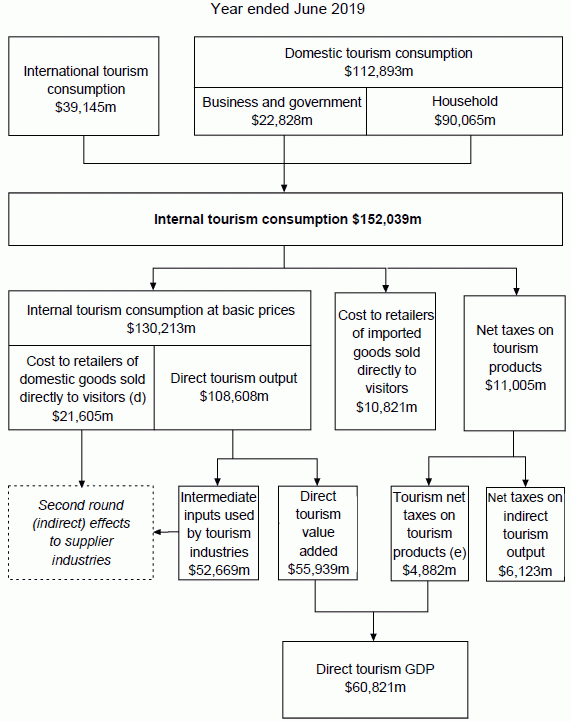Key figures
| Tourism | Total Economy | ||
|---|---|---|---|
| Gross Domestic Product (GDP) | |||
| Current prices | 6.0 | 5.3 | |
| Chain volume measure | 3.4 | 1.9 | |
| Gross Value Added at basic prices | |||
| Current prices | 6.1 | 5.4 | |
| Chain volume measure | 3.3 | 1.9 | |
| Employed persons | 3.3 | 2.4 | |
| Hours worked index | 2.6 | 2.1 | |
| Gross value added per hour worked | 0.6 | -0.2 |
Chain volume measures source: Australian System of National Accounts (cat. no. 5204.0)
2018-19 key points
Chain volume measures
- Direct tourism Gross Domestic Product (GDP), in volume terms, increased by 3.4%, compared with real GDP growth of 1.9%.
- Direct tourism gross value added at basic prices, in volume terms increased by 3.3%, compared to gross value added for all industries which increased by 1.9%.
- Internal tourism consumption (total domestic and international consumption in Australia) in volume terms, increased by 3.1%. Of this figure, domestic tourism consumption increased by 3.4% while international tourism consumption grew by 2.0%.
- Direct tourism gross value added per hour worked (a measure of tourism labour productivity) increased by 0.6% compared to growth for the whole economy which fell by -0.2%.
Current price measures
GDP
- Direct tourism GDP increased by 6.0% to $60,821m, compared with GDP growth of 5.3%.
- Tourism share of GDP remained unchanged at 3.1%.
Industry gross value added
- Direct tourism gross value added increased by 6.1% to $55,939m.
Tourism consumption
- Internal tourism consumption increased by 6.2% to $152,039m.
- Domestic tourism consumption increased by 6.7% to $112,893m.
- Tourism exports (international tourism consumption in Australia) increased by 4.6% to $39,145m.
- Tourism imports (outbound tourism consumption by Australian residents on outbound trips) increased by 7.8% to $58,306m.
Tourism employment
- Tourism employed persons increased by approximately 21,500 employees to approximately 666,000 employed persons.
- Tourism share of total employment remained stable at 5.2%.
- Hours worked in tourism increased by 2.6%, compared with an increase of 2.1% for the overall economy.
